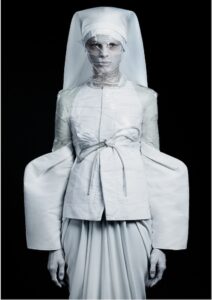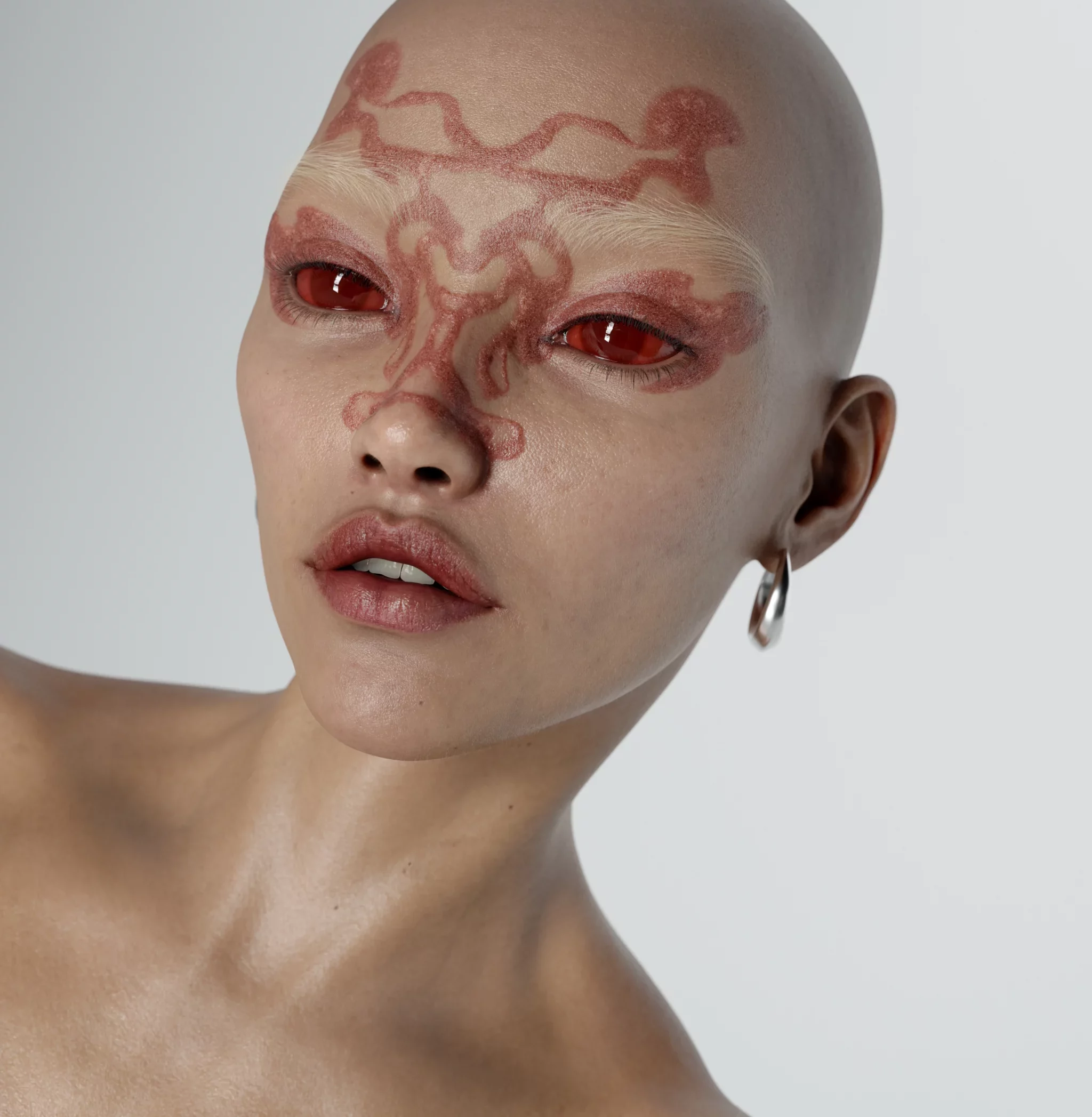
Ctrl + Alt + Fashion : How Digital Culture is Shaping Aesthetics
While the fashion industry has drawn inspiration from the internet for years, a new wave of digital-first aesthetics is accelerating the evolution of trends.
As digital bodies and virtual fashion become increasingly commonplace, we begin to wonder: how might we step into these augmented, hyperreal versions of ourselves? And in what ways will digital culture continue to influence the physical clothes we wear every day?
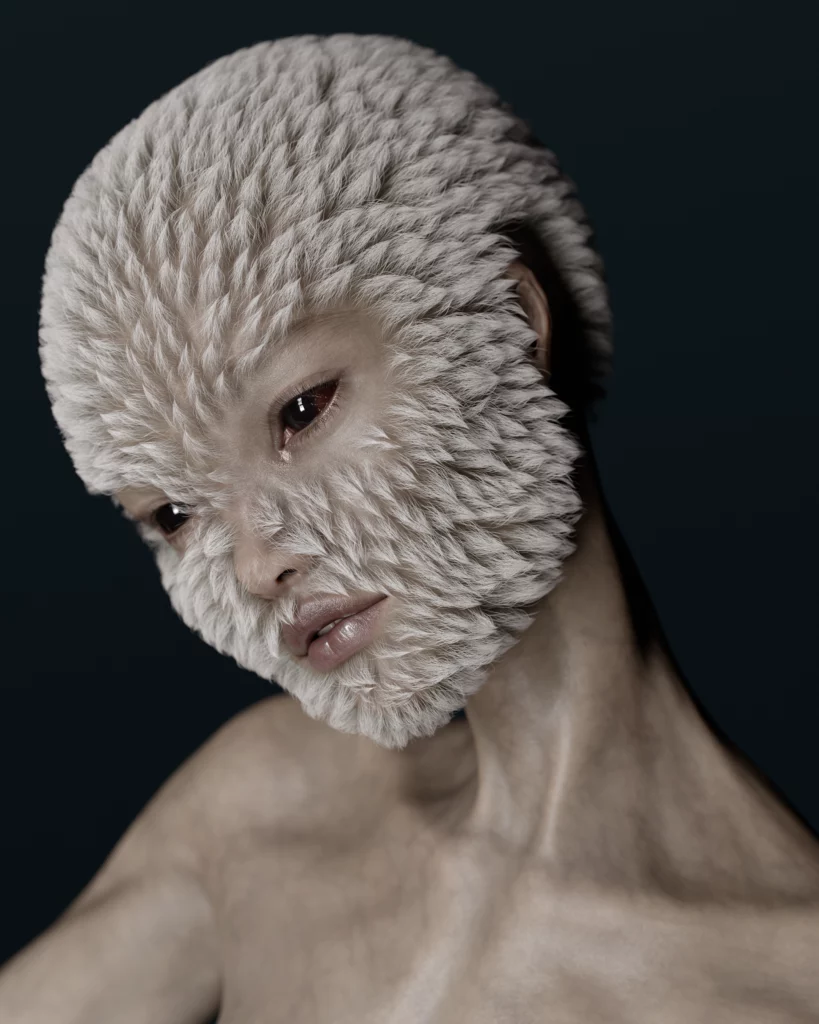
“Monstera” by Craves
Translucent skin, glitch-inspired pixelated fabrics, and otherworldly garments sculpted from massive metallic forms are just a few of the emerging fashion trends that began as digital-first concepts and are now slowly seeping into the realm of physical fashion and beauty. They are forcing us to rethink how we perceive identity, self-expression, and even the very nature of appearance.
On platforms like Instagram and TikTok, we are now subtly consuming increasingly surreal depictions of the human form, through digital avatars or virtual garments, as more creatives adopt 3D modeling and CGI tools to craft their digital art.
These hyperreal, often fantastical visuals offer a glimpse into a world where our identities are no longer bound by the limitations of the physical body. Skin can become translucent, clothes can glitch, and our forms can be distorted, fluid, and endlessly mutable.
At its core, the Post-Internet can be defined as a 21st-century art movement that directly engages with the internet, examining its impact on aesthetics, culture, and society. But today, the influence of digital culture has extended far beyond the bounds of a niche art movement, it is inescapable.
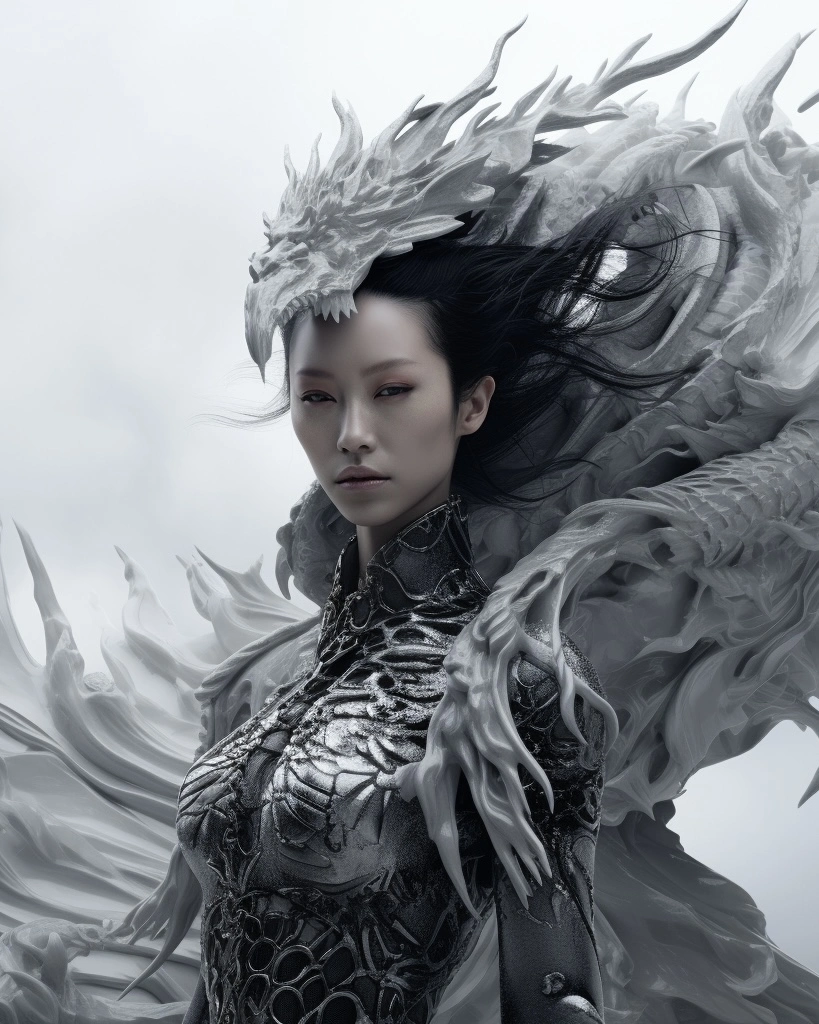
Digital Artwork by Yimeng Yu

“Horsey” by Harriet Davey
In recent years, digital creators like Harriet Davey and Yimeng Yu, along with digital fashion houses such as DRESSX, Tribute, and The Fabricant, have achieved viral success, collectively amassing over one million Instagram followers, by sharing gravity-defying silhouettes and hyper-expressive, surreal depictions of the human form detached from biological constraints. This growing trend highlights how artists are curating visions of how humans might break free from the limitations of the physical body and the physical world.
These digital fantasies, blurring the lines between reality and imagination, are helping to shape a new narrative of self-expression through fashion, both in virtual environments and in the tangible world.
Physical Fashion
Advancements in Augmented Reality (AR) have significantly elevated digital fashion, with companies like ZERO10 offering filter-based try-on solutions that bring virtual designs to life on our screens. As a result, the distinction between the digital and physical worlds is becoming increasingly fluid, creating a dynamic two-way interaction. This shift has inspired designers to push creative and material boundaries, exploring avant-garde silhouettes and unconventional materials inspired by the infinite possibilities of digital space.
Han Kjøbenhavn, an emerging Denmark-based brand, is a strong example of this evolution. The label pushes the envelope with dramatic, futuristic designs such as oversized shoulder pads, sculptural metal heels with sword-like details, and chest armor. Almost like a video game brought to life.
Other new-age designers translating digital-first concepts into physical collections include KAY KWOK (KWK), a Shanghai- and London-based designer known for experimenting with digital fashion for the metaverse. KWK brings these fantastical concepts into the physical world using 3D printing technology. He first creates bold shapes and volumes in the digital realm, and the resulting sculptural garments reflect the visual language of these very platforms. His work has attracted high-profile figures like Beyoncé, Björk, and Karol G.
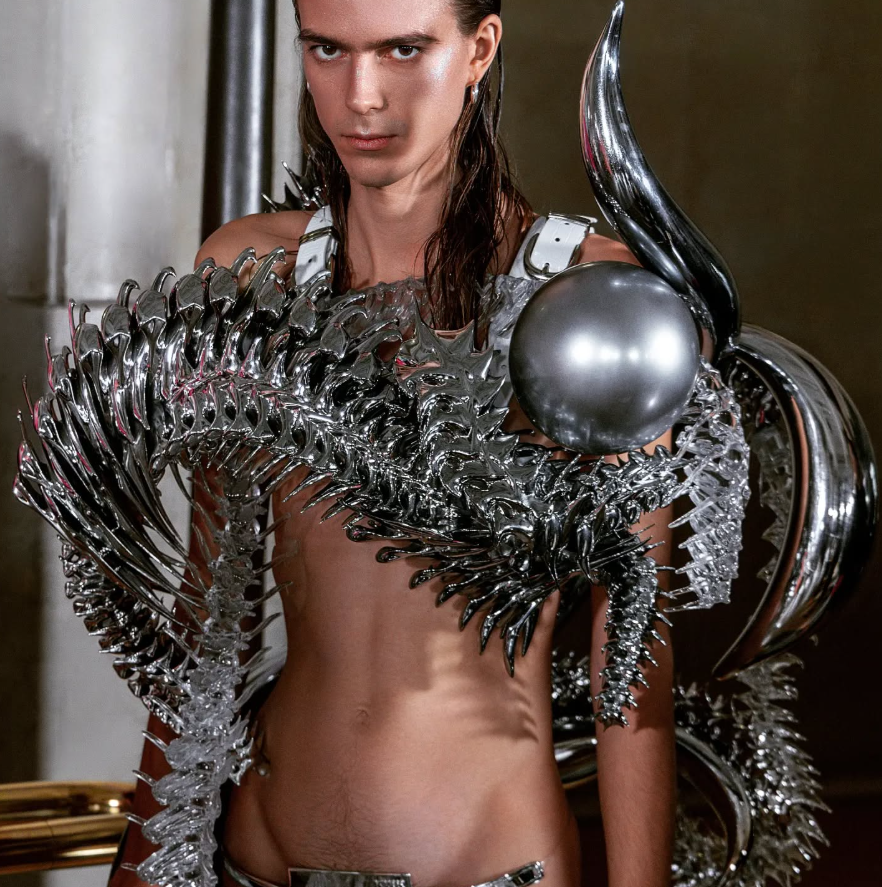
3D Printed Fashion Inspired by Digital Aesthetics by KWK
Chrome, metallic, glitchcore, and other digital-inspired hues and silhouettes, which once existed primarily within 3D modeling software, are now being realized through technologies like 3D printing and are making their way onto the runway, transforming virtual ideas into tangible, wearable garments.
Paris-based designer Rohan Mirza is another example of this trend. Known for creating 3D-printed prosthetic-like jewelry, Mirza’s designs include spiral earrings that extend outward into space and rings that wrap entirely around the hand, blurring the line between fashion, sculpture, and augmentation.
Digital Beauty
Digital aesthetics are disrupting not only physical garments but beauty standards as well. Digital creators like Carol Civre, Craves, Marc Tudisco, Zemengze, Anubvision, and many others are using technology to explore fashion as something no longer placed on the body, but as something that becomes an extension of the body, even of the self. They demonstrate that we are developing entirely new ways to represent ourselves, unbound by biology or physics.
These artists are pushing the boundaries of adornment, blending it seamlessly with the body through digital body modifications, virtual skins, responsive pixels, or surreal, biophilic aesthetics that defy physical limitations. As we are constantly inundated with images of virtual influencers, avatar bodies, and CGI-generated humans (often adorned with metallic, chrome-like skin), digital platforms are evolving into hubs of radical self-exploration, where fashion and beauty standards are no longer fixed but fluid, shifting, and ever-changing.

Digital Artwork by Anubvision
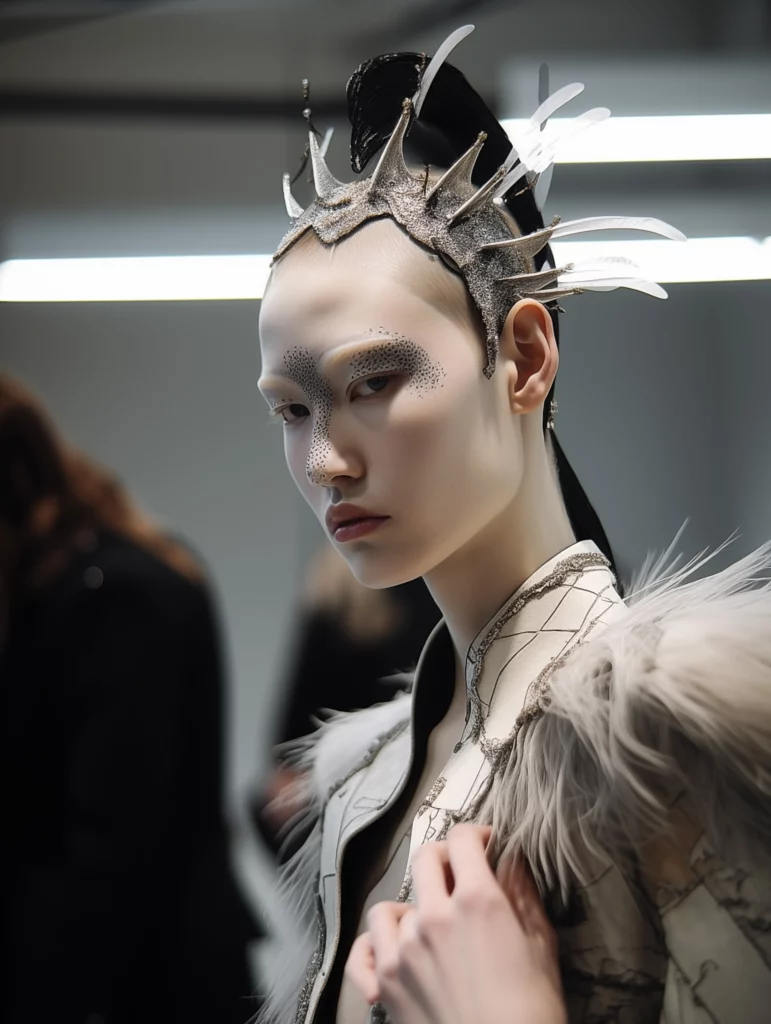
Artworks by Anub Vision
On the runway, Diesel, Marine Serre, Rick Owens, Valentino, and Dion Lee are not only placing beauty on the lips, eyes, and cheeks, they are extending it across the entire body. This aesthetic approach, reminiscent of the virtual influencers we see online, disrupts our traditional perceptions of physical human beauty and pushes the boundaries of how we conceive it.
Perhaps increased exposure to digital identities might open up new possibilities to diversify real-life beauty standards, offering more ways to express ourselves through representations that truly reflect who we are. This shift invites us to reconsider how digital avatars and virtual self-representation can challenge conventional beauty norms, promote the acceptance of diverse body types, and counter the narrow ideals perpetuated by mainstream media, ultimately turning fashion into a fluid exploration of the self rather than a garment separate from the body.


Rick Owens, FW2019
Transhumanism
As human representations become increasingly digital, artists are contributing to the conversation around the possibilities of depicting beauty in a utopian, idealized way. Another, perhaps more concerning, impact of these digital images is how they may also contribute to an increasingly optimized and digitally inspired beauty ideal.
At what point does viewing our bodies as canvases for technology shift from sci-fi fantasy to sci-fi nightmare?
Victor Clavelly is a CGI artist and a beautifully unconventional emerging fashion designer based in Paris. While Clavelly focuses on transforming the body into creature-like, dominant, powerful, or unorthodox forms through 3D rendering and distortion, as well as through garments that explore the dialogue between technology and the human body, aligning human evolution with digital progress, he admits he is still “slightly afraid of transhumanism.” Although clothing inspired by digital aesthetics can “play the role of a prosthesis to the body and can augment it,” Clavelly concludes, “transhumanism could be much less sexy than in Cyberpunk 2077.”
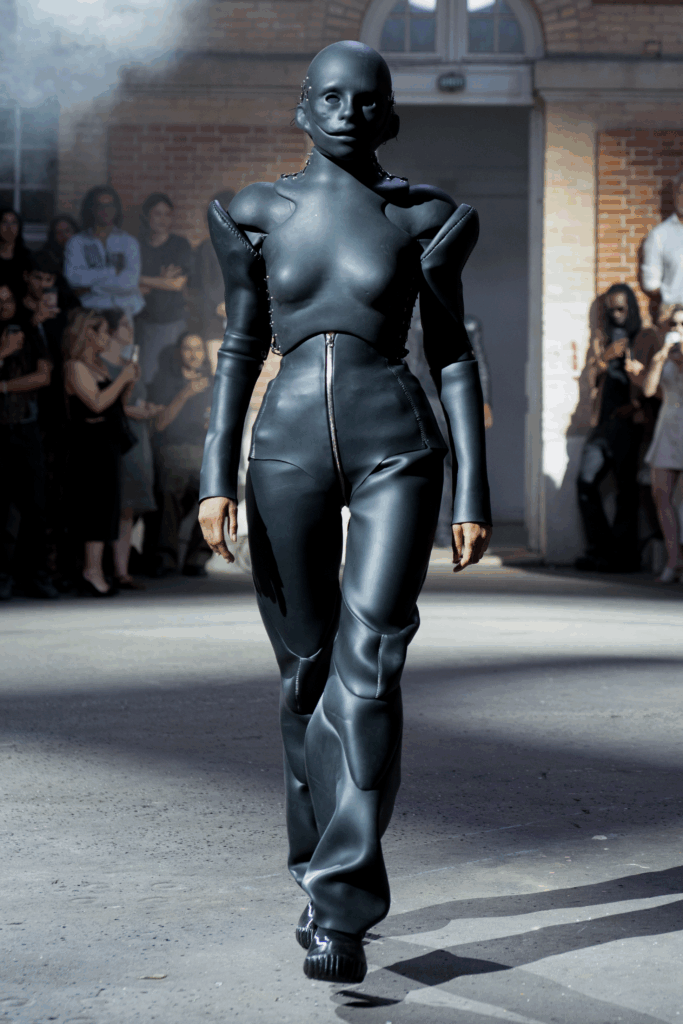
Victor Clavelly, SS2026
Though the line between artistic innovation and dystopian fantasy is becoming increasingly difficult to define, digital aesthetics are raising critical questions about the intersection of technology, humanity, and the ethics of digital manipulation. It is still very clear that digital culture will only become further embedded in fashion and beauty.
On a practical level, this new wave opens up exciting possibilities for material innovation and more diverse forms of representation. Yet, on a philosophical level, it also prompts us to reconsider how we define and express identity through the human form, with access to increasingly sophisticated creative technology.
Ultimately, as digital and physical worlds continue to converge, we can assume that fashion will no longer be just about clothing; it will become a vehicle for personal exploration, a reflection of the body’s limitless potential, and an evolving dialogue between who we are and who we can become. What was once confined to the realms of sci-fi may soon become an everyday reality, inviting us to reimagine beauty and identity in ways that are as boundless and fluid as the digital spaces we inhabit.
Credits
Written by Grace Robinson

